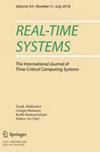Feasibility of on-line speed policies in real-time systems
IF 1.4
4区 计算机科学
Q3 COMPUTER SCIENCE, THEORY & METHODS
引用次数: 0
Abstract
We consider a real-time system where a single processor with variable speed executes an infinite sequence of sporadic and independent jobs. We assume that job sizes and relative deadlines are bounded by C and $$\varDelta $$ Δ respectively. Furthermore, $$S_{\max }$$ S max denotes the maximal speed of the processor. In such a real-time system, a speed selection policy dynamically chooses ( i.e. , on-line) the speed of the processor to execute the current, not yet finished, jobs. We say that an on-line speed policy is feasible if it is able to execute any sequence of jobs while meeting two constraints: the processor speed is always below $$S_{\max }$$ S max and no job misses its deadline. In this paper, we compare the feasibility region of four on-line speed selection policies in single-processor real-time systems, namely Optimal Available $${\text{(OA)}}$$ (OA) (Yao et al. in IEEE annual foundations of computer science, 1995), Average Rate $${\text{(AVR)}}$$ (AVR) (Yao et al. 1995), $${\text{(BKP)}}$$ (BKP) (Bansal in J ACM 54:1, 2007), and a Markovian Policy based on dynamic programming $${\text{(MP)}}$$ (MP) (Gaujal in Technical Report hal-01615835, Inria, 2017). We prove the following results: $$ {\text{(OA)}}$$ (OA) is feasible if and only if $$S_{\max } \ge C (h_{\varDelta -1}+1)$$ S max ≥ C ( h Δ - 1 + 1 ) , where $$h_n$$ h n is the n -th harmonic number ( $$h_n = \sum _{i=1}^n 1/i \approx \log n$$ h n = ∑ i = 1 n 1 / i ≈ log n ). $${\text{(AVR)}}$$ (AVR) is feasible if and only if $$S_{\max } \ge C h_\varDelta $$ S max ≥ C h Δ . $${\text{(BKP)}}$$ (BKP) is feasible if and only if $$S_{\max } \ge e C$$ S max ≥ e C (where $$e = \exp (1)$$ e = exp ( 1 ) ). $${\text{(MP)}}$$ (MP) is feasible if and only if $$S_{\max } \ge C$$ S max ≥ C . This is an optimal feasibility condition because when $$S_{\max } < C$$ S max < C no policy can be feasible. This reinforces the interest of $${\text{(MP)}}$$ (MP) that is not only optimal for energy consumption (on average) but is also optimal regarding feasibility.实时系统中在线速度策略的可行性
我们考虑一个实时系统,其中单个处理器以可变速度执行无限序列的零星和独立的作业。我们假设作业规模和相对截止日期分别由C和$$\varDelta $$ Δ限定。此外,$$S_{\max }$$ S max表示处理器的最大速度。在这样的实时系统中,速度选择策略动态地选择(即在线)处理器执行当前尚未完成的作业的速度。我们说在线速度策略是可行的,如果它能够执行任何作业序列,同时满足两个约束:处理器速度始终低于$$S_{\max }$$ S max,并且没有作业错过其截止日期。在本文中,我们比较了单处理器实时系统中四种在线速度选择策略的可行性区域,即最优可用$${\text{(OA)}}$$ (OA) (Yao等人,1995年IEEE计算机科学年度基础),平均速率$${\text{(AVR)}}$$ (AVR) (Yao等人,1995年),$${\text{(BKP)}}$$ (BKP) (Bansal In J ACM 54:1, 2007)和基于动态规划的马尔可夫策略$${\text{(MP)}}$$ (MP) (Gaujal In Technical Report hal-01615835, Inria, 2017)。我们证明了以下结果:$$ {\text{(OA)}}$$ (OA)当且仅当$$S_{\max } \ge C (h_{\varDelta -1}+1)$$ S max≥C (h Δ - 1 + 1)时是可行的,其中$$h_n$$ h n为n次谐波数($$h_n = \sum _{i=1}^n 1/i \approx \log n$$ h n =∑i = 1 n 1 / i≈log n)。$${\text{(AVR)}}$$ (AVR)当且仅当$$S_{\max } \ge C h_\varDelta $$ S max≥C h Δ可行。$${\text{(BKP)}}$$ (BKP)当且仅当$$S_{\max } \ge e C$$ S max≥e C(其中$$e = \exp (1)$$ e = exp(1))时可行。$${\text{(MP)}}$$ (MP)当且仅当$$S_{\max } \ge C$$ S max≥C时可行。这是一个最优可行性条件,因为当$$S_{\max } < C$$ S max < C时,没有策略是可行的。这加强了$${\text{(MP)}}$$ (MP)的兴趣,它不仅在能源消耗(平均)方面是最佳的,而且在可行性方面也是最佳的。
本文章由计算机程序翻译,如有差异,请以英文原文为准。
求助全文
约1分钟内获得全文
求助全文
来源期刊

Real-Time Systems
工程技术-计算机:理论方法
CiteScore
2.90
自引率
7.70%
发文量
15
审稿时长
6 months
期刊介绍:
Papers published in Real-Time Systems cover, among others, the following topics: requirements engineering, specification and verification techniques, design methods and tools, programming languages, operating systems, scheduling algorithms, architecture, hardware and interfacing, dependability and safety, distributed and other novel architectures, wired and wireless communications, wireless sensor systems, distributed databases, artificial intelligence techniques, expert systems, and application case studies. Applications are found in command and control systems, process control, automated manufacturing, flight control, avionics, space avionics and defense systems, shipborne systems, vision and robotics, pervasive and ubiquitous computing, and in an abundance of embedded systems.
 求助内容:
求助内容: 应助结果提醒方式:
应助结果提醒方式:


